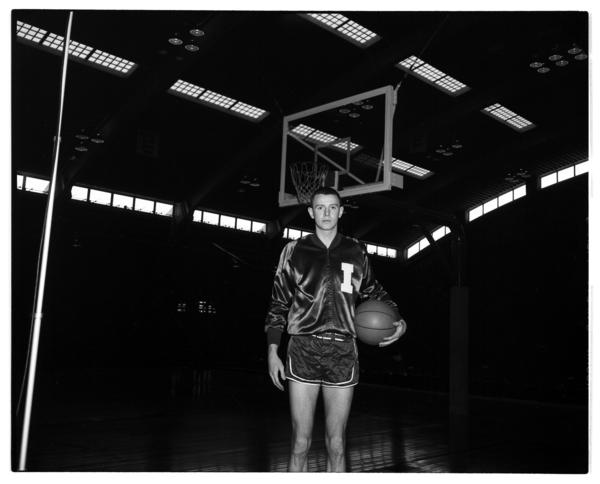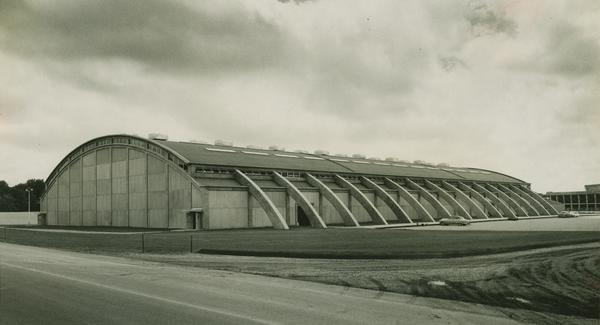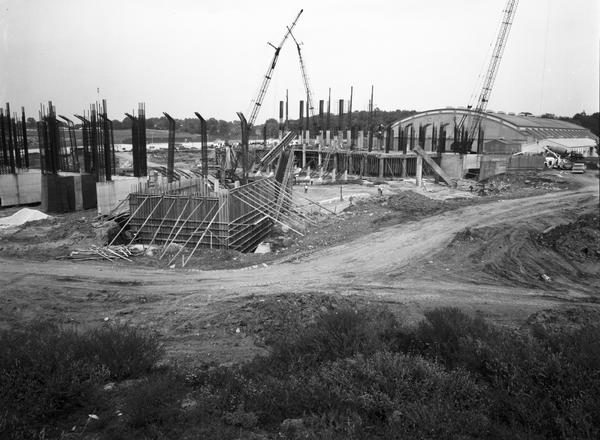This is the fourth in a five-part series on the historic home courts of the Indiana University basketball program. Today we take a look at the fourth home of the Hoosiers — the New Fieldhouse.
A Temporary Solution That Became an Eleven Season Home
The January 6, 1958 Indianapolis News reported that IU had announced plans to accept bids on a new $13 million “Athletic Plant” that would include a new football stadium, a new basketball arena and more. The original plans at this time called for a 15,000 seat arena, which was the facility that we now know as Simon Skjodt Assembly Hall. In addition to the large basketball arena, a new fieldhouse was contemplated as a third facility for track and field and other sports.
The Athletic Plant was to be placed just north of campus. Having sporting events in the heart of the campus was becoming a major challenge for a number of reasons. The land on the north side of 17th Street was a family farm that IU had acquired to expand its athletic facilities, make more room for a growing campus, and provide for better game day parking.
IU put the multi-structure plan out for bid — and it soon became clear that building everything at once was not economically feasible. With football being the major revenue generating sport, Memorial Stadium and the New Fieldhouse were slated to be built first. The large basketball arena would have to wait.
The February 18, 1959 Indianapolis News reported that construction plans had been finalized on the New Fieldhouse, with an estimated completion date for November 15 later that same year. The News went on to report that the new facility “will be used as a temporary headquarters for basketball until the new 18,000 seat arena is built.”
IU was originally scheduled to begin play at the New Fieldhouse for the 1959-60 season, but inclement weather delayed construction.
The December 3, 1960 Indianapolis Star filed a report in anticipation of the opening game. It indicated that the capacity for the New Fieldhouse would be around 10,300, far short of the originally hoped for 12,500. Much like the Old Fieldhouse, the new structure utilized portable seating and a portable court that was raised higher than the benches.
With 9,236 fans in attendance, the first game was played in the New Fieldhouse on December 3, 1960. The error prone Hoosiers committed 25 turnovers that day, but handled an overmatched Indiana State 80-53. All-American and future NBA Hall of Famer Walt Bellamy led the way with 20 points.

The Indianapolis Star reported that much of the buzz and anticipation to start that season centered around first year players in sophomores Jimmy Rayl and Tom Bolyard. Although he played in the opener, IU fans would have to wait another year for Rayl to truly electrify the New Fieldhouse.
On January 27, 1962, Rayl set a new Big Ten scoring record with an amazing 56 point game on IU’s home court. The Kokomo native put an exclamation point on his big night with a 25-foot shot with two seconds left in overtime to give IU a 105-104 win over Minnesota. IU head coach Branch McCracken called it “one of the greatest exhibitions of outside shooting that I have ever seen.”

McCracken would see yet another great exhibition from Rayl in 1963. On February 23, 1963, Rayl went for 56 once again at the New Fieldhouse. This time he did it in regulation time in a 113-94 IU win over Michigan State. The Indianapolis Star reported that 8,636 ecstatic fans were in the New Fieldhouse to witness it.
Interestingly, Rayl had only scored 2 points in IU’s previous game before the 56 point outburst. He had scored 44 points in the game at East Lansing earlier that season, giving him 100 points against the Spartans on the season.


One of the more noteworthy games in the New Fieldhouse’s run as the home court of the Hoosiers wasn’t witnessed by very many people — and that was the problem. On January 18, 1965 Bloomington Fire Marshal Ira Anderson recommended that the capacity be reduced from more than 10,000 to 3,400 due to inadequate exits. The IU trustees decided to follow the recommendation and Indiana was forced to play a home game with two thirds of the seats empty.
McCracken was not at all happy with the decision to limit attendance at the game.
“Why that’s like playing on a neutral floor with only 3,400 people in the stands.” McCracken was quoted as saying in the January 19, 1965 Indianapolis Star.
IU lost the game 74-68 against Iowa. The fire marshal’s edict would impact one more game against Loyola before things got back to normal. Indiana was ranked No. 5 in the country at the time of the Iowa game but never recovered and finished in 4th in the Big Ten. Just imagine the outrage today if a decision like that was made when Indiana was ranked in the top 5.
That 1964-65 team was likely the best team that the Hoosiers put together in their 11 seasons in the New Fieldhouse. IU finished 19-5 that year, which was the last season for the legendary McCracken.
McCracken coached his final home game vs. Purdue on March 6, with IU beating the Boilermakers 90-79. The two-time national champion was reported by the Indianapolis Star as receiving a huge ovation from the crowd and a plaque following the game.
Indiana would win just one Big Ten title during the New Fieldhouse era. Improbable as it was, coach Lou Watson led the Hoosiers to the 1966-67 conference crown despite finishing in 9th both the year before and the year after.
Watson led the program through seven roller coaster seasons, with Jerry Oliver filling in during the 1969–70 season and for the final game of the 1970-71 season.

By 1967 the plans for Assembly Hall were finally approved by the IU board of trustees despite protests by student government leaders. Construction began later that same year, and the once temporary solution was finally slated to be replaced.

The final season played in the New Fieldhouse was, if nothing else, an entertaining one. An exciting group of first year players included sophomores George McGinnis, Steve Downing and John Ritter. McGinnis had what was likely the best individual statistical season in Indiana basketball history, averaging 29.9 points and 14.7 rebounds per game. Behind their upstart youngsters, No. 18 Indiana stood at 16-4 overall and 8-2 in the conference with four Big Ten games remaining.
That once promising 1970-71 season fell apart down the stretch, with IU losing three of its last four. The season ended mercifully at the New Fieldhouse on March 13, 1971. Illinois handled IU 103-87. Lou Watson had resigned only days earlier amid player controversy. The just 7,286 fans in attendance that day gave a standing ovation to McGinnis after he fouled out. The Indianapolis native set the IU all-time single season scoring record in the game with a season low 17 points on the day, giving him 719 for the season.
While there were certainly some highlights during the New Fieldhouse era, it sits sandwiched in between two of the more legendary times in program history. The following season Indiana and its new head coach Bob Knight moved into the enormous new Assembly Hall.
Just 5 years later they would achieve perfection, with the New Fieldhouse sitting next door, now in the shadows. Its eleven year “temporary” job was complete.
Indiana had a total record of 138-128 during the New Fieldhouse era. They were 85-41 during that time playing at home.
A NEW PURPOSE — AND A NEW NAME
Harry Gladstein was a 1931 IU graduate who was a student manager for the track team while at Indiana. The Gladstein family made a major donation in the 1990s that allowed the New Fieldhouse to undergo a $1 million renovation. In 1997 the facility was renamed the Gladstein Fieldhouse.
It continues on as the home of the IU track and field program. It is connected via a hallway to Simon Skjodt Assembly Hall, and in much the same way, it served as a bridge between two great eras of IU basketball.

You see a brief video showing all five IU home courts here.
*We acknowledge IU author and historian Bill Murphy for bringing the “fire marshal game” to our attention. You can pick up his book “The Indiana Hoosiers Fans’ Bucket List” on Amazon here:
You can follow us on Twitter: @daily_hoosier
Find us on Facebook: thedailyhoosier




